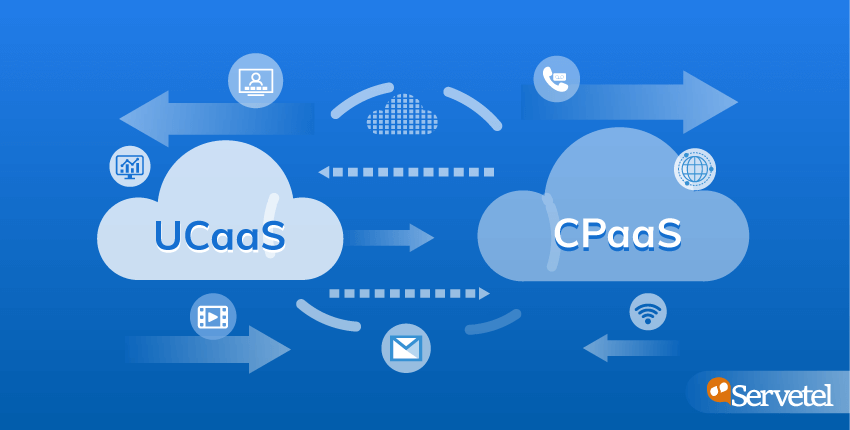The customers these days get in touch with a business/brand through multiple communication channels. But the choice of communication channel differs from one customer to another. Several studies suggest that customers prefer dealing with business using digital communication channels like websites, mobile apps, web chat, emails, social media and web self-service.
At the same time, many research studies also suggest that customers still prefer non-digital communication channels like telephone to digital communication channels. Hence, no business can boost customer experience and meet customer expectations without unifying conventional and digital customer communication channels.
Both Unified Communications as a Service (UCaaS) and Communication Platform as a Service (CPaaS) help enterprises to unify business communication and integrate multiple communication channels. The widely used cloud delivery models help businesses to modernize and transform their communication strategy by availing a variety of tools, solutions, and services over the internet on demand.
Unified Communications as a Service (UCaaS)
UCaaS allows businesses to boost communication and collaboration by accessing a variety of cloud-based solutions and services on demand. This has created a buzz in the business world for UCaaS. An enterprise has the option to choose from a wide range of UCaaS platforms. Most UCaaS platforms allow enterprises to avail a slew of communication solutions and services hosted in the cloud – enterprise messaging, team collaboration and video conferencing.
However, the sophisticated UCaaS solutions allow businesses to avail important contact center features like interactive voice response (IVR) system implementation, call recording, auto attendant and customer relationship management (CRM) system integration. The leading providers make their UCaaS platforms market-relevant by adding new application programming interfaces (APIs) and CPaaS on a regular basis.
The enterprises also have the option to access UCaaS using two distinct models or architectures – single-tenancy and multi-tenancy. The single tenancy model enables the subscriber to use the software platform exclusively, while the multi-tenancy architecture requires the subscribers to share the software platform with other tenants/subscribers. In addition to facilitating software customization, single-tenancy is considered to be more reliable and secure than multi-tenancy.
Communication Platform as a Service (CPaaS)
CPaaS allows businesses to add real-time communication capabilities to their existing enterprise applications by leveraging cloud computing. A business can use the cloud delivery model to add voice, video, messaging and similar real-time communication features to its existing enterprise applications and solutions using specific APIs.
For instance, a business can use specific APIs to enable its existing sales software or marketing solutions to send SMS, MMS, voice messages and video clips over the internet. Many businesses take advantage of CPaaS to make customer communication more engaging and personalized by modernizing and upgrading their existing software solutions. A business can easily embed communication capabilities in various applications and services by choosing from a wide range of cloud service providers.
The CPaaS solutions typically come with standard-based APIs, software development kits (SDKs) and libraries for widely used developer platforms like Java and .NET. However, some providers make it easier for businesses to add real-time communication feature to the existing applications by providing prepackaged and fully-functional communication features. Hence, the components of CPaaS solutions differ across providers.
UCaaS vs. CPaaS
Both UCaaS and CPaaS are widely used cloud delivery models. A business can access both cloud delivery models based on monthly subscription plans. But UCaaS and CPaaS differ from each other in a number of aspects. The decision makers must keep in mind major differences between UCaaS and CPaaS to enhance business communication by choosing the right cloud delivery model.
Cloud Delivery Models
The UCaaS and CPaaS are different cloud delivery models. UCaaS falls under the category of Software as a Service (SaaS), while CPaaS falls under the category of Platform as a Service (PaaS). Like other PaaS, CPaaS requires additional customization, implementation, and modification. At the same time, UCaaS allows businesses to access a variety of ready-to-go services and solutions according to their specific needs.
Important Features
Both UCaaS and CPaaS allow businesses to avail most of the features and functionalities provided by on-premise or conventional communication tools. UCaaS boosts business communication by allowing subscribers to avail important features like team collaboration, enterprise messaging, telephony and video conferencing as cloud-based services and solutions. On the other hand, CPaaS helps subscribers to add communication capabilities like voice, video and messaging to their existing business applications.
Architecture/Models
As noted earlier, a business has the option to choose from two models or architectures while accessing UCaaS. The single-tenancy model is more secure and reliable than multi-tenancy model. But it requires businesses to incur additional expenses. However, a business does not have any option to choose from multiple models or architectures while accessing CPaaS. It can further allow employees to access the CPaaS both internally and externally.
Software Customization
The cloud-based solutions and services are easier to customize than conventional software applications. UCaaS allows businesses to boost internal and external communication by accessing and combining the required solutions. Although, the businesses still lack the option to customize the cloud-based solutions and services fully. On the other hand, the APIs and SDKs provided by CPaaS enable businesses to build custom communication platforms according to their precise communication needs.
Best Suitable
Most businesses lack the expertise and skill required to use the APIs and SDKs provided by CPaaS. Hence, businesses opt for CPaaS when they want to build their own communication platforms or add real-time communication capability to their existing applications. On the other hand, UCaaS enables businesses to boost communication using ready-to-go solutions and services. Many businesses these days use UCaaS to handle internal communication and use CPaaS to boost external communication.
Cost Efficiency
Both UCaaS and CPaaS helps businesses to curtail infrastructural cost by leveraging cloud computing. UCaaS allows businesses to avail a variety of cloud-based services and solutions on demand without building and maintain hardware-based infrastructure. But CPaaS helps businesses to extend and upgrade their existing communication stack. The businesses need to focus on hardware-based infrastructure while using CPaaS to add communication features to on-premise applications.
As widely used cloud delivery models UCaaS and CPaaS help businesses to improve omnichannel customer communication. However, the cloud delivery models differ from each other in several aspects. A business can use any of the two cloud delivery model regardless of its size and industry. CPaaS helps businesses to optimize their existing communication channels, while UCaaS enable businesses to leverage innovative communication solutions and services.
Want to know more? Call us at 1800-120-4132.

















